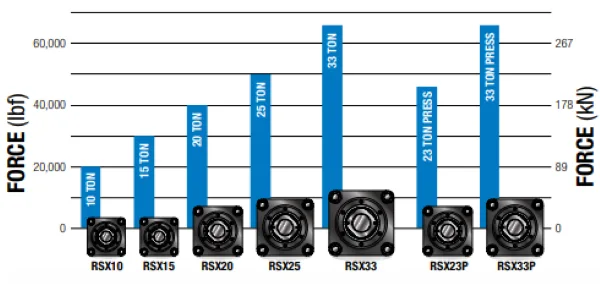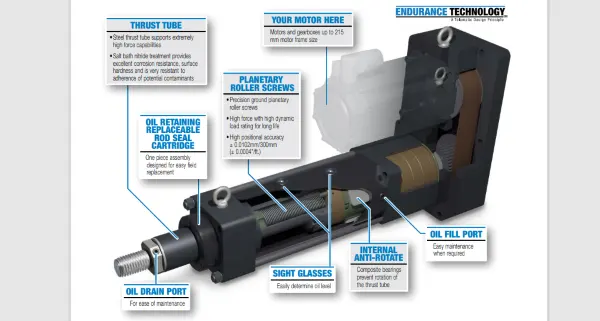
Tolomatic has introduced five new RSX high-force electric linear actuators to meet a broader range of applications. These high-force actuators may be a better option than traditional hydraulics.
Tolomatic’s addition of five new linear actuators attempts to persuade traditionalists to switch from hydraulic to electric systems. These linear actuators include forces of up to 66,000 lbf (294 kN) and have some advantages over hydraulic systems. Let’s explore the capabilities, specs, and benefits of electric over hydraulic systems.
This image clarifies Tolomatic’s RSX actuators' force capabilities, which forms the argument for replacing traditional hydraulic systems. Image used courtesy of Tolomatic
RSX Electric Linear Actuator Spotlight
Although the primary selling point of the newly introduced RSX Electric Linear Actuators is their high-force capabilities, they also have many other specifications that may persuade users to make the switch.
The RSX linear actuators are designed to provide cleanliness and durability. They have an IP67 option to protect against dust and water and a food-grade design option. Users can feel confident that these actuators meet standards for various industries. Additionally, these actuators feature a heavy-duty internal bumper that protects moving components at both ends of the stroke, where wear and tear are commonly compounded. They also have high positional accuracy, with the roller nut capable of ±0.0102mm/300mm and the ball nut ±0.102mm/300mm.
Multiple Options Available
These actuators are available in ball and planetary roller screw-driven designs. These options allow users to decide which actuator best suits their needs. The deciding factors depend on the user's requirements, such as power density, linear velocity, life expectancy, accuracy and repeatability, and relative cost. Roller screw designs allow for more power density because of the extension of contact points, allowing the load to be distributed more evenly.
Ball screws have lower power density and life expectancy but offer increased efficiency in high-speed applications, with a 90% efficiency rating. In contrast, roller screws have an 80% efficiency rating. Whether users lack accuracy needs but require power density or prefer the most life expectancy, Tolotmatic actuators suit application needs.
Tolomatic offers a super-duty option known as the RSX096 oil-cooled option. This option suits applications that need higher duty cycles and power than traditional grease and lubrication designs can handle. The oil-cooled option design efficiently transfers heat throughout the moving components of the cylinder, allowing it to handle a 100% duty cycle while also providing a long life expectancy. It's the best of both worlds. 
This is an image of the RSX096 Oil Cooled Option Actuator. Image used courtesy of Tolomatic
Electric Vs. Hydraulic Actuators
When choosing between hydraulic and electric actuators, several factors must be considered to ensure the best fit for your application.
Hydraulic actuators can produce high forces and speeds, making them suitable for heavy-duty applications, but they may not offer the same level of precision as electric actuators. Electric actuators provide better precision and control, making them ideal for applications requiring accurate positioning.
They also require less maintenance and eliminate the risk of fluid leaks, making them cleaner and more environmentally friendly. Additionally, electric actuators are suitable for a wide range of environments, including extreme temperatures and cleanroom settings. They are typically more energy-efficient as they convert electrical energy directly into mechanical motion.
Electric actuators generally have a higher initial cost but lower operating and maintenance costs in the long term. In contrast, hydraulic actuators, though often used in harsh environments, can be affected by temperature changes and require robust sealing, leading to higher long-term maintenance and operational costs. These factors will help you determine the best actuator type for your needs.


